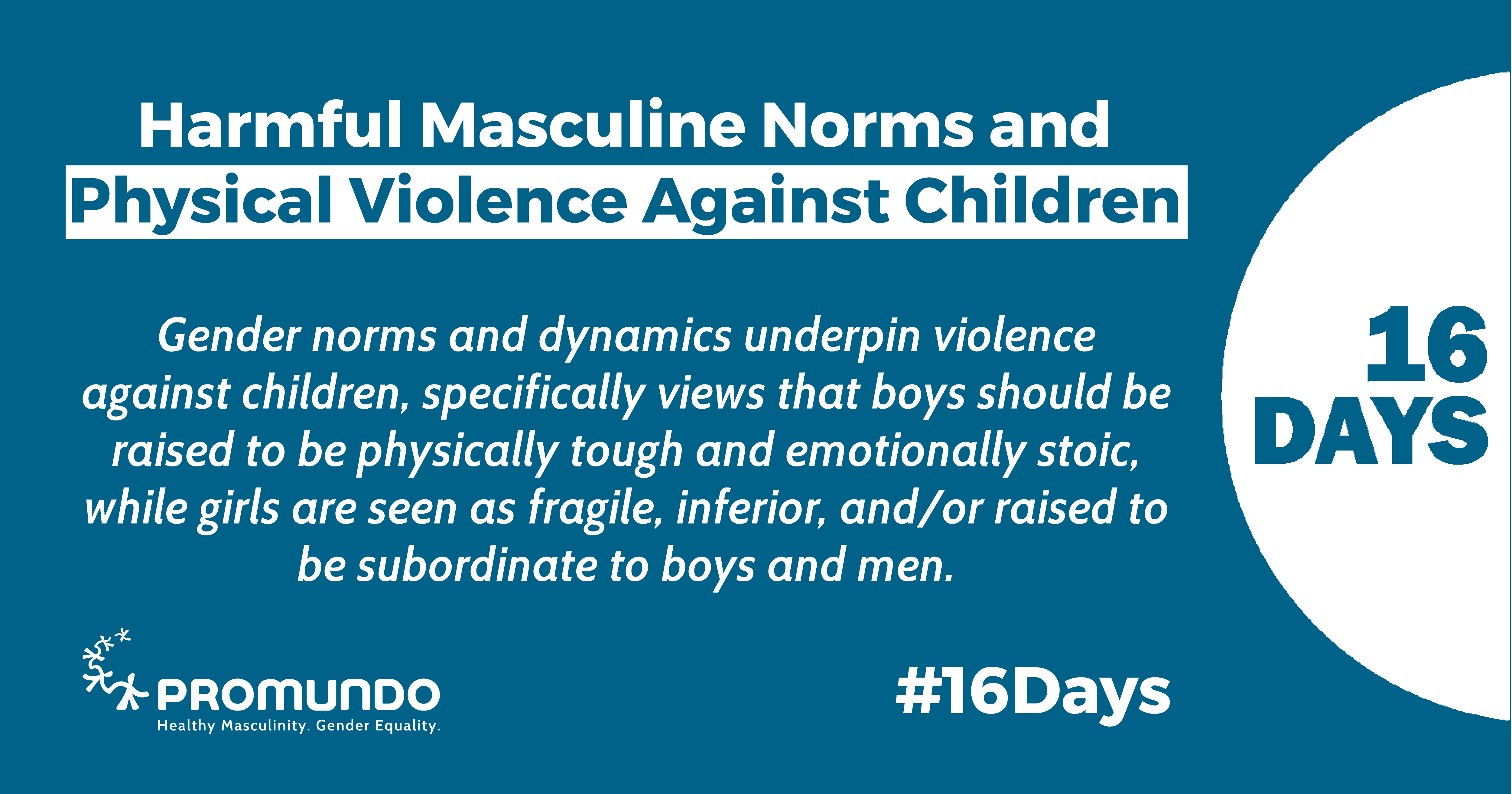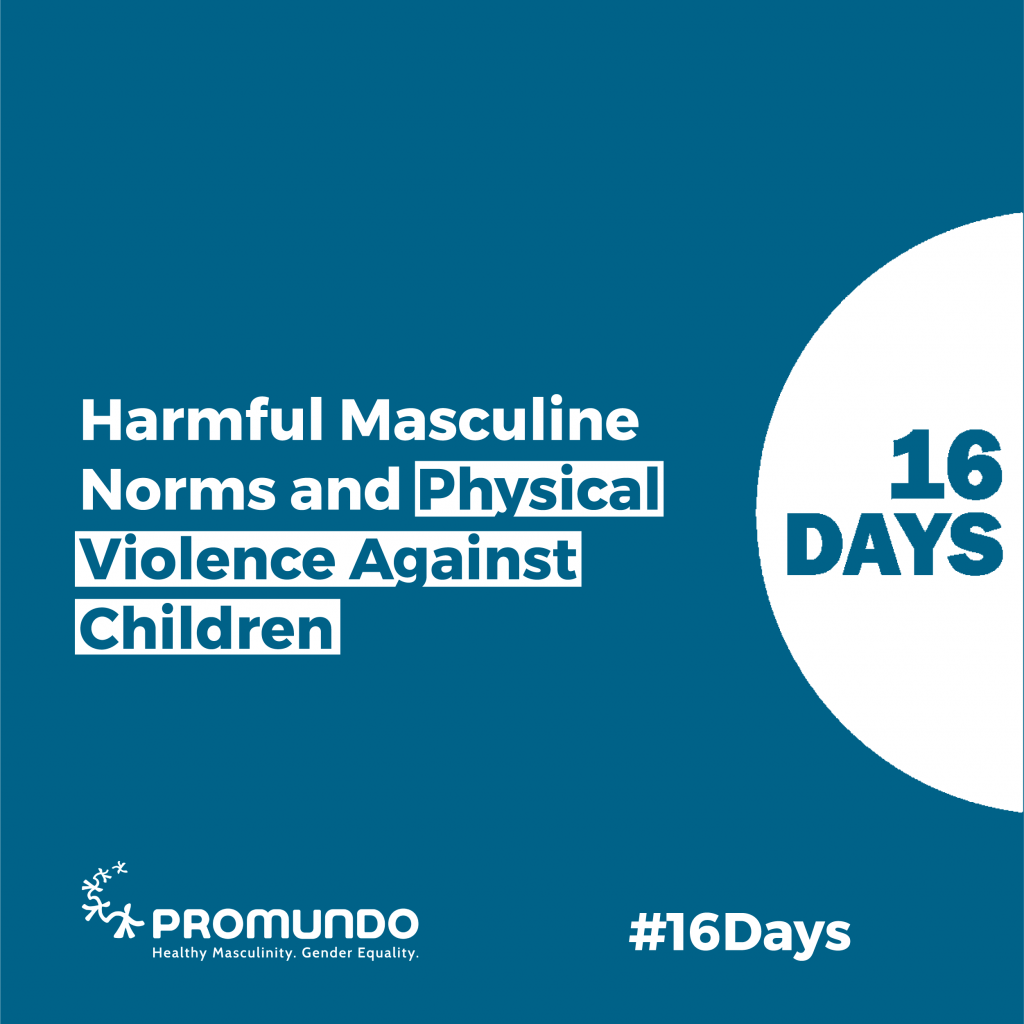Os 16 Dias de Ativismo Contra a Violência de Gênero são uma campanha internacional usada por ativistas ao redor do mundo (25 de novembro a 10 de dezembro) como uma estratégia de organização para pedir a eliminação de todas as formas de violência de gênero.
Este ano, compartilharemos pesquisas sobre as ligações entre normas masculinas prejudiciais e oito formas diferentes de comportamento violento, bem como insights e recomendações para eliminar todas as formas de violência.

Embora não haja nada inerente ao fato de ser homem que impulsione a violência, a maneira como socializamos os meninos em suas identidades como homens e o que esperamos deles — isto é, as normas masculinas da sociedade — estão inegavelmente ligados à violência.
De fato, meninos e homens são frequentemente criados, socializados e incentivados a usar a violência de alguma forma; em geral, homens e meninos têm uma probabilidade desproporcional de perpetrar a maioria das formas de violência e de morrer por homicídio e suicídio. No entanto, a pesquisa afirma que essa violência é prevenível, a igualdade de gênero é alcançável e normas e ideias não violentas sobre masculinidade são predominantes e poderosas.
Relatório da Equimundo e da Oak Foundation Normas Masculinas e Violência: Fazendo as Conexões, examina as ligações entre normas masculinas nocivas e oito formas de comportamento violento. Este segundo blog da série Fazendo as conexões, 16 Dias de Ativismo A série se concentra na violência física contra crianças. Ela analisa os fatos sobre o assunto, explora as ligações entre a violência física contra crianças e outras formas de violência e fornece recomendações para ação.
Violência física contra crianças
Os fatos
A violência contra crianças abrange uma ampla gama de comportamentos, desde castigos corporais (que muitos em uma determinada sociedade podem considerar uma parte normal da criação de uma criança) até manifestações mais extremas de violência física, passando por atos de abuso emocional e negligência. De acordo com dados do Fundo das Nações Unidas para a Infância (UNICEF) de 30 países, quase metade de todas as crianças entre 12 e 23 meses são sujeitas a castigos corporais e/ou abuso verbal em casa.
Os Links
A violência também é um mecanismo pelo qual os pais controlam o desempenho de gênero dos filhos, repreendendo-os ou punindo-os por agirem de maneiras masculinas ou femininas "inaceitáveis". A violência dentro do lar também é um meio primário pelo qual as crianças percebem, aprendem e internalizam os desequilíbrios hierárquicos de poder entre e dentro dos gêneros.
Como décadas de pesquisa sobre a transmissão intergeracional da violência demonstraram, crianças que testemunham ou vivenciam violência em casa têm probabilidade significativamente maior de perpetrar ou vivenciar violência doméstica na vida adulta, em comparação com aquelas cujos lares de infância não foram afetados pela violência. A violência contra crianças, portanto, reforça duplamente a ordem de gênero, traumatizando-as diretamente e, ao mesmo tempo, aumentando a probabilidade de elas seguirem padrões comportamentais semelhantes com seus próprios filhos, bem como a probabilidade de os homens usarem violência contra suas parceiras e aceitarem a violência de gênero como "normal".
As Interseções
Em interação com as características individuais e experiências de vida dos cuidadores e das crianças, há três fatores convincentes que sustentam a violência contra crianças:
- Pobreza e desigualdades estruturais moldam os cenários de cuidado e frequentemente afetam se os pais, as famílias e outros cuidadores têm ou não os meios para cuidar adequadamente de seus filhos de maneiras não violentas e sem estresse.
- Normas culturais e sociais estão relacionadas às práticas de criação dos filhos e à aceitabilidade do castigo corporal e de outras formas de violência contra crianças (e contra mulheres, indivíduos com gênero não-conforme e entre homens e meninos). O grau em que a violência contra mulheres, incluindo e além de indivíduos transgêneros, não binários e com gênero não-conforme, e crianças é normalizada na sociedade desafia a narrativa de que os perpetradores são "monstros" – particularmente "homens maus" – ou de que o problema não é cultural e social.
- Normas e dinâmicas de gênero sustentam a violência contra crianças, especificamente as ideias de que os meninos precisam ser criados para serem fisicamente fortes e emocionalmente estoicos, enquanto as meninas devem ser frágeis, inferiores e/ou subordinadas aos meninos e homens.
Da Teoria à Prática
As iniciativas que visam prevenir a violência contra crianças devem concentrar-se nas seguintes transformações das normas masculinas nocivas:
- Peça aos participantes que reflitam e reconheçam as divisões de gênero nos padrões de trabalho de cuidado, provisão financeira e disciplina.
- Incentive os pais a adotar uma gama completa de comportamentos de cuidado e carinho em seus relacionamentos com os filhos.
- Permita espaços seguros para os pais praticarem abordagens parentais positivas e disciplina não física.
- Peça aos participantes que nomeiem, reconheçam e discutam as desigualdades de poder em seus relacionamentos com os filhos.
- Peça aos participantes que reflitam sobre maneiras pelas quais eles criam ou disciplinam seus filhos homens de forma diferente de suas filhas ou filhos não binários.
- Peça aos participantes que reflitam sobre os efeitos limitantes da socialização de gênero para o desenvolvimento da identidade, do potencial, das habilidades, das aspirações, dos relacionamentos e das oportunidades de vida das crianças.
